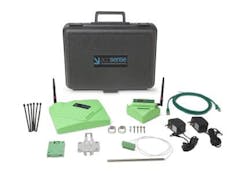Cool technology may get geeks excited, but in the workaday world of the factory floor, most end-users don’t care about the technology. Instead, what they want is affordable, easy-to-use products or systems that can help them solve problems, regardless of the technologies deployed.
That realization seems to be driving a new approach to the packaging and marketing of industrial wireless mesh sensor networks. Two recent announcements mark the trend.
On April 25, Accsense Inc., a Santa Barbara, Calif., start-up, rolled out what it bills as “the industry’s first turnkey wireless sensor product.” Users can have the system running and measuring physical properties such as temperature within five minutes of taking it out of the box, the company contends, with no software installation or complex configuration required.
Similarly, at the National Manufacturing Week conference in March near Chicago, Sensicast Systems Inc., of Needham, Mass., unveiled its Sensicast Wireless Advantage line of turnkey industrial wireless solutions. The Sensicast approach features pre-configured systems aimed at specific applications—including temperature monitoring, predictive maintenance and energy monitoring. And like Accsense, Sensicast says its systems are designed to “work out of the box, and are up and running immediately.”
Cool? Who cares?
In both new offerings, the underlying technology is wireless mesh networking, which is based on a “self-organizing” and “self-healing” network topology that carries with it a certain technical allure. But so far, the technology has been slow to take off for widespread use in factory sensor monitoring applications.
“I think a lot of us in the mesh networking business thought, ‘Gee, this is cool technology. Think of all the things that people could do with it,’ ” observes Paul Richards, Sensicast vice president of business development. In the past, Richards says, Sensicast focused on selling the “infrastructure” of wireless sensor networking. But with the Wireless Advantage offering, the company has now changed its marketing approach to focus on specific, pre-packaged “solutions” for the factory, he says.
“We’re really changing the company quite a bit. We’re going from a technology orientation to a systems orientation, because we found that people weren’t beating a path to our door just because we had mesh,” confirms Gary Ambrosino, who joined Sensicast as chief executive officer last January.
The Sensicast Wireless Advantage offering is based on the company’s proprietary SensiNet wireless network protocol. It includes wireless sensor nodes that accommodate a range of popular sensor types, wireless mesh network repeater nodes, a gateway that connects the wireless network to the wired world, and Sensicast’s OnCall applications software.
Make it easy
With an eye on ease-of-use, Sensicast has pulled together the components needed—in some cases, working with partners—to create packaged, turnkey solutions for a variety of specific applications, Richards says. One solution makes use of human-machine interface (HMI) technology from partner Citect Inc., in Alpharetta, Ga., for example, as well as current sensors from NK Technologies, Campbell, Calif., another partner, for use in wireless compressed air monitoring applications. Sensicast wireless mesh systems are priced typically from about $5,000 to $50,000 for solutions ranging from about four or five nodes up to 300 nodes, respectively, Richards says.
At Accsense, Product Manager Tobin Greensweig says his company is also placing a heavy premium on ease-of use. Most competitive mesh systems use dedicated nodes that either work with sensors to gather data, or work as repeaters on the wireless network, Greensweig says. Accsense, by contrast, makes use of “full mesh” technology—with nodes that can serve both functions, he notes. “Every single one of our sensor Pods can both take a reading, and also repeat the messages from other sensor Pods in the area.” This makes the network easier for users to set up, Greensweig says.
Further, the Accsense product requires no software installation by users, Greensweig points out. “This thing has been fully productized, in that data from the sensors shows up on a Web site that we maintain and take care of for people.” Most other mesh network systems require users to write database software for handling the sensor data or to load application software on a personal computer or other system, he says.
Pod pricing
The Accsense product line includes wireless sensor Pods that measure ambient temperature, humidity, light, noise and vibration, and are also compatible with a range of external plug-in sensors and probes. The Pods are priced from $295 to $635 depending on the combination of measurements and inputs. A Pod Gateway, priced at $795, can support up to 16 wireless Pods, says Greensweig.
The Gateway connects to the Internet and links to the Accsense-hosted online service, enabling users to monitor their sensor data online and to download it for deeper analysis. A standard online account is free, and users can pay $24.95 per month for a premium account that offers additional features such as analytical charting and alarms that send alerts to cell phones, pagers and e-mail when measurements fall out of range.
Both the Accsense and Sensicast solutions rely on proprietary protocols that are built on top of the Institute of Electrical and Electronic Engineers IEEE 802.15.4 wireless standard, which supports mesh networking.

